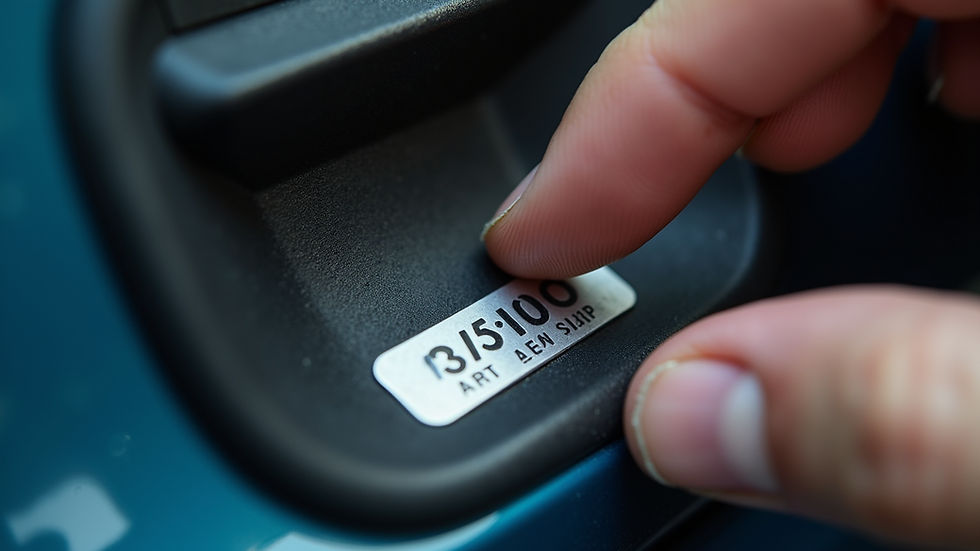Why Vehicle Identification Numbers Are Essential
- David Briscoe

- 1 day ago
- 4 min read
When it comes to owning or buying a vehicle, one of the most important pieces of information you need to know is the vehicle ID number. This unique code is more than just a string of letters and numbers - it holds the key to a vehicle’s history, authenticity, and legal status. Understanding why the vehicle ID number is essential can save you from costly mistakes and help you make informed decisions.
What Is a Vehicle ID Number and Why It Matters
The vehicle ID number, often abbreviated as VIN, is a 17-character code assigned to every motor vehicle when it is manufactured. This code acts like a fingerprint for the vehicle, providing a unique identifier that distinguishes it from all other vehicles worldwide.
Why is this important?
It helps track the vehicle’s history, including accidents, repairs, and ownership changes.
It is used by law enforcement to identify stolen vehicles.
It ensures the vehicle matches its registration and title documents.
It assists in recalling defective parts or safety issues.
For example, if you are buying a used car, checking the vehicle ID number can reveal if the car has been in a major accident or if it has a salvage title. This information can influence your decision and negotiation.

How the Vehicle ID Number Helps in Vehicle Identification
The vehicle ID number is a standardized code that contains specific information about the vehicle’s make, model, year, manufacturing plant, and serial number. This makes it a powerful tool for identification.
Here’s how the vehicle ID number breaks down:
World Manufacturer Identifier (WMI) - The first three characters identify the manufacturer and country of origin.
Vehicle Descriptor Section (VDS) - Characters 4 to 9 describe the vehicle type, model, and body style.
Vehicle Identifier Section (VIS) - Characters 10 to 17 provide the model year, assembly plant, and serial number.
This detailed coding system allows anyone with access to a VIN decoder to learn a lot about a vehicle without seeing it physically. For instance, insurance companies use the vehicle ID number to verify the exact model and year before issuing a policy.

Where do I find the vehicle identification number VIN?
Knowing where to locate the vehicle ID number on your vehicle is crucial for verification and record-keeping. The VIN is typically found in several places on a vehicle:
Dashboard: On the driver’s side, visible through the windshield. This is the most common and easiest place to find the VIN.
Driver’s side door jamb: On a sticker or metal plate when you open the door.
Engine block: Stamped on the engine itself.
Vehicle registration and title documents: The VIN is always listed on official paperwork.
If you are unsure, you can also check your vehicle’s manual or contact the manufacturer. When buying a used car, always verify that the VIN on the vehicle matches the one on the documents to avoid fraud.

Practical Uses of the Vehicle ID Number in Everyday Life
The vehicle ID number is not just for manufacturers or law enforcement - it has many practical uses for everyday vehicle owners:
Buying a Used Car: Use the VIN to check the vehicle’s history report from services like Carfax or AutoCheck. This can reveal accidents, title issues, or odometer fraud.
Registering Your Vehicle: The DMV requires the VIN to register your vehicle and issue license plates.
Insurance: Insurance companies use the VIN to calculate premiums and verify coverage.
Recalls and Safety Notices: Manufacturers use the VIN to notify owners of recalls or safety defects.
Theft Recovery: Police use the VIN to track and recover stolen vehicles.
By keeping your vehicle ID number handy, you can quickly access important information and protect your investment.
Tips for Verifying and Protecting Your Vehicle ID Number
To make the most of your vehicle ID number, follow these actionable recommendations:
Always verify the VIN before purchasing a vehicle. Use online VIN check tools or professional services to get a detailed report.
Keep a record of your vehicle’s VIN in a safe place. This can help in case of theft or loss of documents.
Inspect the VIN on the vehicle carefully. Look for signs of tampering or alteration, which could indicate fraud.
Use professional VIN verification services if you are unsure about the authenticity of the number.
Report any discrepancies to authorities immediately. This can prevent legal issues down the road.
For those looking for reliable VIN verification, consider trusted providers like Rollin VIN Verifiers who specialize in accurate and thorough checks.
The Role of Vehicle ID Number in Vehicle Safety and Compliance
The vehicle ID number also plays a critical role in ensuring vehicle safety and regulatory compliance. Governments and manufacturers use the VIN to:
Track compliance with emissions standards.
Monitor safety inspections and certifications.
Manage recalls and repairs efficiently.
Enforce laws related to vehicle registration and ownership.
This system helps maintain road safety and protects consumers from unsafe vehicles. For example, if a manufacturer issues a recall for faulty airbags, they will notify owners based on the VIN range affected.
Understanding the importance of the vehicle ID number empowers you to make smarter decisions about your vehicle. Whether you are buying, selling, insuring, or maintaining a car, this unique identifier is your key to transparency and security. Always take the time to verify and protect your vehicle’s VIN to ensure peace of mind on the road.



.png)




Comments